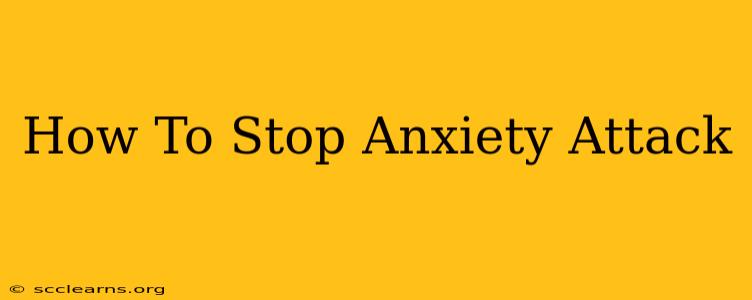Anxiety attacks can feel overwhelming, leaving you breathless and terrified. But understanding what triggers them and learning effective coping mechanisms can significantly reduce their impact. This guide provides practical techniques you can use to stop an anxiety attack in its tracks and regain control.
Understanding Anxiety Attacks
Before diving into solutions, it's crucial to understand what's happening during an anxiety attack. Your body is experiencing a surge of adrenaline, triggering physical symptoms like rapid heartbeat, shortness of breath, dizziness, sweating, and trembling. These physical sensations often amplify feelings of fear and panic, creating a vicious cycle.
Recognizing the Signs
Knowing the early warning signs of an anxiety attack is key to managing them. These can vary from person to person, but common indicators include:
- Increased heart rate: Noticeably faster heartbeat.
- Shortness of breath: Feeling like you can't catch your breath.
- Muscle tension: Tightness in your shoulders, neck, or jaw.
- Dizziness or lightheadedness: Feeling faint or unsteady.
- Trembling or shaking: Involuntary muscle movements.
- Nausea or upset stomach: Digestive discomfort.
- Feeling of impending doom: An overwhelming sense of dread or fear.
Techniques to Stop an Anxiety Attack
Once you recognize the symptoms, immediately implement these techniques to help stop the attack:
1. Deep Breathing Exercises:
This is arguably the most effective technique. Deep, slow breaths help regulate your nervous system and slow your racing heart. Try these methods:
- Box Breathing: Inhale slowly for a count of four, hold for four, exhale slowly for four, and hold for four. Repeat.
- Diaphragmatic Breathing: Place one hand on your chest and the other on your stomach. Breathe deeply, focusing on expanding your stomach, not your chest.
2. Grounding Techniques:
Grounding techniques help bring you back to the present moment, reducing the intensity of anxious thoughts. Try these:
- 5-4-3-2-1 Method: Name five things you see, four things you touch, three things you hear, two things you smell, and one thing you taste.
- Sensory Focus: Concentrate on a specific sensory detail – the texture of your clothes, the temperature of the air, a sound in the environment.
3. Muscle Relaxation:
Progressive muscle relaxation involves tensing and releasing different muscle groups to reduce physical tension. Start with your toes and work your way up your body.
4. Positive Self-Talk:
Replace negative thoughts with positive affirmations. Remind yourself that this feeling is temporary and that you can manage it.
5. Mindfulness Meditation:
Regular mindfulness practice can significantly reduce anxiety levels. Even short meditation sessions can help calm your mind and body.
Seeking Professional Help
While these techniques can be highly effective, it's crucial to remember that seeking professional help is not a sign of weakness. If anxiety attacks are frequent, severe, or significantly impacting your daily life, consult a therapist or psychiatrist. They can provide personalized strategies, including therapy and potentially medication, to help you manage your anxiety.
Preventing Future Attacks
In addition to managing attacks, proactive steps can help prevent future occurrences. These include:
- Identifying and Managing Triggers: Keep a journal to identify situations, thoughts, or feelings that trigger your anxiety.
- Regular Exercise: Physical activity releases endorphins, which have mood-boosting effects.
- Healthy Diet: Nourish your body with a balanced diet.
- Sufficient Sleep: Aim for 7-9 hours of quality sleep per night.
- Stress Management Techniques: Incorporate stress-reducing activities like yoga, meditation, or spending time in nature.
By combining these strategies for immediate relief with proactive measures for prevention, you can significantly reduce the frequency and intensity of anxiety attacks and live a more fulfilling life. Remember, you are not alone, and help is available.

